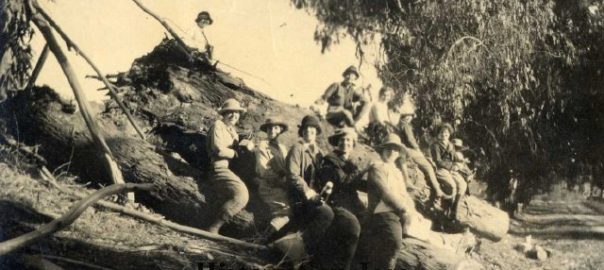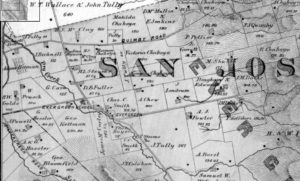 Part of the joy in this project has been trying to imagine Evergreen of yesteryear. How I’ve initially ingested the information is through the visuals which develop throughout time. The Pueblo de San Jose was established in 1777 as the first secular settlement in California’s infancy. Small towns and communities would grow up around the city in order to feed and sustain it. Evergreen was certainly one of these communities, with its first recorded landowners being the Chaboyas in 1821.
Part of the joy in this project has been trying to imagine Evergreen of yesteryear. How I’ve initially ingested the information is through the visuals which develop throughout time. The Pueblo de San Jose was established in 1777 as the first secular settlement in California’s infancy. Small towns and communities would grow up around the city in order to feed and sustain it. Evergreen was certainly one of these communities, with its first recorded landowners being the Chaboyas in 1821.
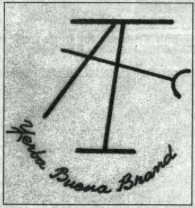
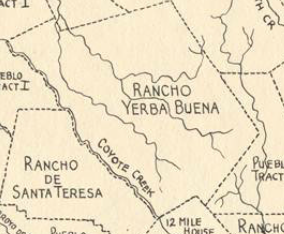 The Chaboyas were cattle ranchers and orchardists. This means much of the area was untouched in years that the cattle didn’t graze across certain acres. Grazing in general is a natural grass mowing. The land itself was scenic, beautiful hillsides drenched in trees and creeks in the 1800’s. It was described at 8 miles outside of the Pueblo.
The Chaboyas were cattle ranchers and orchardists. This means much of the area was untouched in years that the cattle didn’t graze across certain acres. Grazing in general is a natural grass mowing. The land itself was scenic, beautiful hillsides drenched in trees and creeks in the 1800’s. It was described at 8 miles outside of the Pueblo.
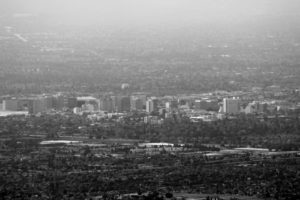 The relationship early landowners had with Evergreen into the 1850’s was very different than what we think of it today. If you were a wealthy farmer, you had a house Downtown – or rather in the City of San Jose – and a vacation or second home in the town of Evergreen. The Pueblo’s plots were close together and very similar to how it looks and feels today. Victorian homes can be traced back to their original owners or builders. The City spread from an epicenter at First Street and Santa Clara Street, being named after the Mission of Santa Clara founded in 1776.
The relationship early landowners had with Evergreen into the 1850’s was very different than what we think of it today. If you were a wealthy farmer, you had a house Downtown – or rather in the City of San Jose – and a vacation or second home in the town of Evergreen. The Pueblo’s plots were close together and very similar to how it looks and feels today. Victorian homes can be traced back to their original owners or builders. The City spread from an epicenter at First Street and Santa Clara Street, being named after the Mission of Santa Clara founded in 1776.
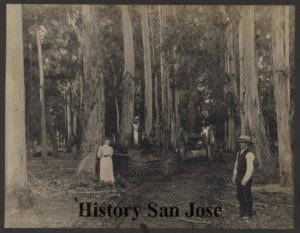 This was certainly true of the Tullys, Quimbys, and Cadwalladers. Shown here are the super trendy Tullys, Rose and John. The Pelliers would own downtown then purchase one of Evergreen’s largest ranches off Quimby Road and Norwood Avenue. Wealthy landowners would have large homes in Evergreen and a pueblo plot, or small lot, in the City. John J. Montgomery would come to fly from Evergreen’s pastoral hillsides while teaching at Santa Clara University. This was a several hour ride on horseback to the town Evergreen in the day, with limited roadways and no highways, at the time.
This was certainly true of the Tullys, Quimbys, and Cadwalladers. Shown here are the super trendy Tullys, Rose and John. The Pelliers would own downtown then purchase one of Evergreen’s largest ranches off Quimby Road and Norwood Avenue. Wealthy landowners would have large homes in Evergreen and a pueblo plot, or small lot, in the City. John J. Montgomery would come to fly from Evergreen’s pastoral hillsides while teaching at Santa Clara University. This was a several hour ride on horseback to the town Evergreen in the day, with limited roadways and no highways, at the time.
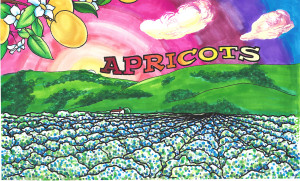 People from elsewhere would travel to Evergreen for a slower paced lifestyle, as well as to tend their lucrative farms. Farmhands would stay on site and the owners would travel back and forth to their downtown stores and homes. Evergreen’s farming community and nature would also bring tourism to a young Evergreen Village. If you were visiting San Jose, you had to make the drive.
People from elsewhere would travel to Evergreen for a slower paced lifestyle, as well as to tend their lucrative farms. Farmhands would stay on site and the owners would travel back and forth to their downtown stores and homes. Evergreen’s farming community and nature would also bring tourism to a young Evergreen Village. If you were visiting San Jose, you had to make the drive.
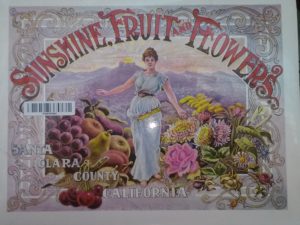 Quick history lesson, Gutenberg’s printing press would be invented in 1444 AD. Throughout the 1800’s the printing press would rapidly improve. The rotary press would be developed in 1843, while the Chaboyas owned Rancho Yerba Buena. Off-set printing would come around in 1875, when the town of Evergreen was a farming haven. Hot metal typsetting would be invented in 1884, around the time James Lick Observatory was built and William Wehner’s Mansion was constructed. Books and publications could be created and distributed much quicker and for less.
Quick history lesson, Gutenberg’s printing press would be invented in 1444 AD. Throughout the 1800’s the printing press would rapidly improve. The rotary press would be developed in 1843, while the Chaboyas owned Rancho Yerba Buena. Off-set printing would come around in 1875, when the town of Evergreen was a farming haven. Hot metal typsetting would be invented in 1884, around the time James Lick Observatory was built and William Wehner’s Mansion was constructed. Books and publications could be created and distributed much quicker and for less.
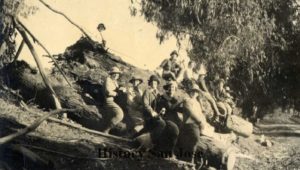 Evergreen being popularized by books and newspapers, hiking groups would come to experience eucalyptus trees imported from Australia, giant oaks, scenic hillsides and natural creek life. Evergreen would come to light through its fruit exports and famed residents.
Evergreen being popularized by books and newspapers, hiking groups would come to experience eucalyptus trees imported from Australia, giant oaks, scenic hillsides and natural creek life. Evergreen would come to light through its fruit exports and famed residents.
 Truth is beyond the suburban developments in Evergreen, there are still vacation spots with stunning vistas and hiking destinations. Evergreen is still at the City’s edge and full of rural beauties, if you know where to look.
Truth is beyond the suburban developments in Evergreen, there are still vacation spots with stunning vistas and hiking destinations. Evergreen is still at the City’s edge and full of rural beauties, if you know where to look.
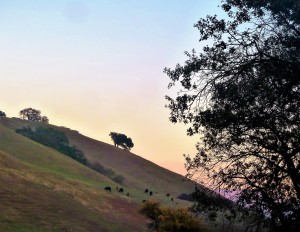 Also, there are still wealthy families who consider Evergreen their vacation destination. These large ranches end up being a link to the past traditions of their families and our Evergreen.
Also, there are still wealthy families who consider Evergreen their vacation destination. These large ranches end up being a link to the past traditions of their families and our Evergreen.
